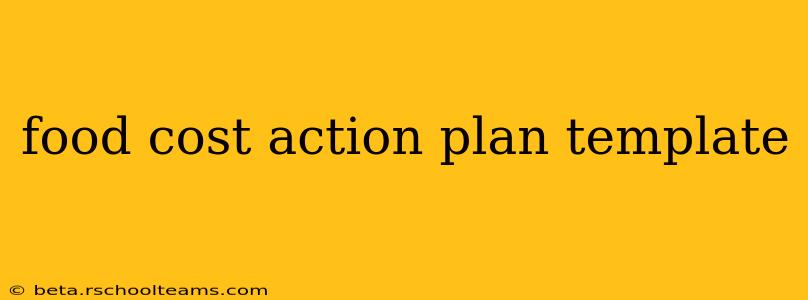Controlling food costs is crucial for the profitability of any food service establishment, from bustling restaurants to small cafes. This food cost action plan template provides a structured approach to identifying areas for improvement and implementing effective strategies to lower your food costs without sacrificing quality. This plan is designed to be adaptable to various business sizes and types.
Understanding Your Current Food Cost Percentage
Before diving into solutions, you need a clear picture of your current food cost percentage (FCP). This is calculated by dividing your total cost of goods sold (COGS) by your total revenue. A healthy FCP typically ranges from 28% to 35%, but this can vary depending on your restaurant's concept and menu.
Step 1: Data Gathering and Analysis
- Detailed Inventory: Conduct a thorough inventory of all your food items, noting quantities and costs. Utilize a robust inventory management system for accuracy.
- Purchase Records: Review your purchase records for the past few months, meticulously tracking all food purchases.
- Sales Data: Analyze your sales data to determine which menu items are most popular and profitable.
- Waste Audit: Perform a waste audit to identify areas of food waste, both in preparation and service. This often reveals significant cost savings opportunities.
- Recipe Costing: Carefully cost out each recipe on your menu, accounting for all ingredients. This forms the basis for accurate pricing and cost control.
Actionable Strategies to Reduce Food Costs
Step 2: Implementing Cost-Saving Measures
Once you have a clear understanding of your current FCP, you can implement targeted strategies:
1. Menu Engineering
- Analyze Profitability: Identify your high-profit and low-profit menu items. Consider increasing prices on high-profit items or adjusting portions/ingredients on low-profit items.
- Menu Optimization: Eliminate underperforming items from your menu, focusing on dishes with higher profit margins and efficient ingredient utilization.
- Strategic Pricing: Use value-based pricing, factoring in both ingredient costs and perceived value to customers.
2. Inventory Management
- Implement FIFO (First-In, First-Out): Use a FIFO system to minimize food spoilage and waste.
- Regular Inventory Counts: Conduct frequent inventory checks to prevent stockouts and overstocking.
- Minimize Ordering Errors: Use a streamlined ordering process to avoid ordering too much or the wrong ingredients.
- Negotiate with Suppliers: Build strong relationships with your suppliers to negotiate better prices and payment terms.
3. Portion Control
- Standardized Recipes: Implement standardized recipes to ensure consistent portion sizes and minimize food waste.
- Employee Training: Train staff on proper portioning techniques.
- Invest in Portion Control Tools: Utilize tools like portion scales and measuring cups for accuracy.
4. Waste Reduction
- Improved Storage: Ensure proper food storage to extend shelf life and minimize spoilage.
- Staff Training on Waste Reduction: Educate your staff on the importance of minimizing food waste and offer incentives.
- Creative Menu Adjustments: Repurpose leftover ingredients to create new menu items or specials.
5. Employee Training and Accountability
- Cross-Training: Cross-train staff to handle multiple roles, which can improve efficiency and reduce labor costs, indirectly impacting food costs.
- Inventory Management Training: Train your staff on proper inventory management procedures to reduce waste and spoilage.
- Recipe Adherence: Ensure staff accurately follows standardized recipes to maintain consistent costs and quality.
Monitoring and Review
Step 3: Ongoing Monitoring and Adjustment
This is not a one-time effort. Regular monitoring is vital.
- Track Your Progress: Monitor your FCP regularly to assess the effectiveness of your strategies.
- Regular Inventory Reviews: Conduct regular inventory reviews to identify potential issues.
- Supplier Relationship Management: Maintain strong relationships with your suppliers for the best possible pricing and service.
- Adapt and Refine: Be prepared to adjust your strategies based on your findings and market changes.
By implementing this comprehensive food cost action plan template, you can significantly reduce your food costs, improve profitability, and create a more sustainable and successful food service operation. Remember to adapt this plan to your specific needs and regularly review your progress for optimal results.
